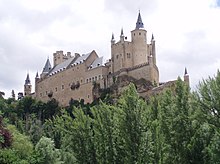Alcázar of Segovia
The Alcázar of Segovia is a castle in the Spanish city of Segovia in the autonomous community of Castile and León .
history
The Alcázar of Segovia is one of the most famous castles in Spain. Construction began in the 11th century, after the Christians gained control of Segovia during the Reconquista . The client was Alfonso VI. The castle was built on a narrow ridge between the Eresma and Clamores rivers . This made the construction of a moth and a moat obsolete. Segovia has repeatedly been the residence of the Spanish kings over the centuries. So many rulers added new features and individual building ideas to the castle complex. The best example is the massive rectangular donjon opposite the old round one. Johann II had it built in the 15th century. On the photo this donjon can just be seen in the background.
The donjon has twelve individual towers on the upper edge, at the same time a viewing terrace. Several machicolations are attached below the towers. According to chronicles, it housed several living rooms.
The tour through the other buildings of the palace leads via the armory and throne room to the “Hall of Kings”. This hall was one of the six ballrooms of the castle, in which 34 gold statues of Spanish kings were placed from the beginning. Philip II expanded this collection to 56 pieces.
There is no real curtain wall . However, the complex is so massive and difficult to access that an additional curtain wall would only have resulted in unnecessary costs. But a smaller wall with a tower-reinforced gatehouse has been built on the access path.
A narrow passage leads into the old courtyard with the old round donjon. The interior of the castle was damaged by fire in 1862, but has been partially restored.
The Alcázar is mentioned for the first time in a document from the 12th century, shortly after the city was conquered by Alfonso VI. During the Middle Ages, the fortress was the preferred residence of the Castilian kings. From there, Isabella the Catholic rode to the Plaza Mayor on December 13, 1474 to be proclaimed the rightful Queen. In the "Galley Hall", named after its ceiling structure in the form of an upturned hull, a modern mural by the contemporary painter Muñoz de Pablos points to this event.
The marriage of Philip II to Anna of Austria took place in the small chapel of the Alcázar .
literature
- Chris Gravett: Atlas of Castles. The most beautiful castles and palaces . Tosa, Vienna 2001, p. 106, ISBN 3-85492-470-4 .
Web links
- The Alcázar of Segovia as a 3D model in SketchUp's 3D warehouse
Coordinates: 40 ° 57 ′ 9 ″ N , 4 ° 7 ′ 58 ″ W.






